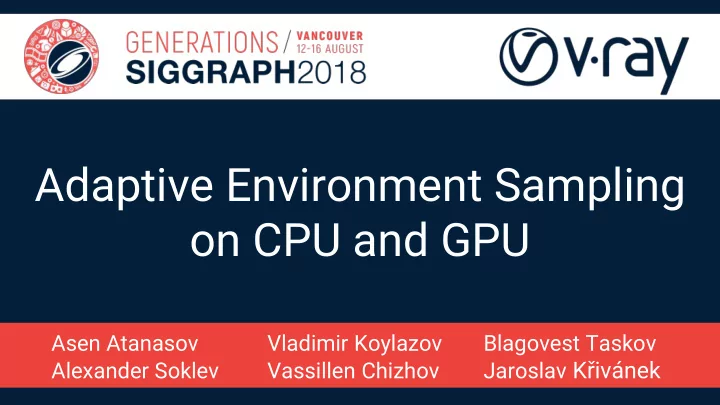

Adaptive Environment Sampling on CPU and GPU Asen Atanasov Vladimir Koylazov Blagovest Taskov Jaroslav Křivánek Alexander Soklev Vassillen Chizhov
Image-based lighting (IBL) HDR images courtesy of NoEmotion
IBL noise
Portals
Existing solutions ● Rely on portals ● High memory consumption ● Expensive computation ● Complex data structures
Guidelines ● Complex production occluded scenes ● CPU and GPU ● Account for visibility ● Lightweight sampling procedure ● No user manual work ● Low memory usage ● Simple to implement
Everything should be made as simple as possible, but not simpler. ~Albert Einstein
Our Adaptive Sampling ● Partition the environment map ● The Light Grid ○ Visibility cache ○ In the camera space ● Two-phase approach ○ Learning ○ Rendering Office scene courtesy of Evermotion
32 equal-energy tiles HDR image courtesy of NoEmotion
32 equal-energy tiles HDR image courtesy of NoEmotion
32 equal-energy tiles - very thin tiles HDR image courtesy of NoEmotion
4 x 8 equal-sized tiles HDR image courtesy of NoEmotion
Equal-energy tiles Equal-sized tiles ● Thin and long tiles ● Equal square tiles ● Degenerate tiles around ● Robust and simple bright spots partitioning ● Traversal or more memory ● Faster point-in-tile test for point-in-tile test HDR images courtesy of NoEmotion
The Light Grid The Light Grid G x x G y spherical grid - G x = 2G y ● In the camera space ●
The Light Grid x G x x G y spherical grid - G x = 2G y ● In the camera space ● ● Each scene point belongs to a Light Grid cell
The Light Grid c[x] x G x x G y spherical grid - G x = 2G y ● In the camera space ● ● Each scene point belongs to a Light Grid cell
Learning phase Tiled environment t3 t2 t1 t0
Learning phase t3 t2 t1 t0 c[x] x
Learning phase t3 t2 t1 t0 c[x] x
Learning phase t3 y t2 c[y] t1 t0 c[x] x
Learning phase t3 y t2 c[y] t1 t0 c[x] x
Rendering phase t3 y t2 c[y] t1 t0 c[x] x
Rendering phase t3 y t2 c[y] t1 t0 c[x] x
Results Office CPU: x6.6 GPU: x3.8 Baseline CPU Our CPU Baseline GPU Our GPU Living room CPU: x2.7 GPU: x2.4 Office scene courtesy of Evermotion
Results HDR “Day” CPU: x2.2 GPU: x1.6 HDR “Sunset” CPU: x1.9 GPU: x1.6 HDR “Night” CPU: x3.8 GPU: x3.0 HDR images courtesy of NoEmotion
Exterior and participating medium CPU: x2.3 GPU: x1.8 CPU: x3.4 GPU: x2.6
Implementation details ● CPU and GPU ● 10% - 700% speedup ● 10MB memory ● Learning: ○ 10 6 camera paths ○ ~ 1% of the render time ○ accumulation with fetch-and-add instructions ● Summed Area Table for sampling
Summed-area table (SAT) A
SAT for sampling D C B A A + D - B - C
Hallway HDR image (10000x5000) HDR image courtesy of Wouter Wynen (Aversis 3D)
Sampling reconstruction - 32-bit Float SAT HDR image courtesy of Wouter Wynen (Aversis 3D)
Sampling reconstruction - 32-bit Integer SAT HDR image courtesy of Wouter Wynen (Aversis 3D)
Integer-valued SAT vs. float-valued SAT HDR image Resolution Int MSE Float MSE Hallway 10000x5000 1.0x10 -5 3.8x10 -1 Day 15000x7500 4.9x10 -7 8.6x10 -3 Night 3000x1500 1.4x10 -8 4.1x10 -4 Sunset 3000x1500 1.1x10 -8 3.6x10 -4
Integer-valued SAT vs. float-valued SAT HDR image Resolution Int MSE Float MSE Hallway 10000x5000 1.0x10 -5 3.8x10 -1 Day 15000x7500 4.9x10 -7 8.6x10 -3 Night 3000x1500 1.4x10 -8 4.1x10 -4 Sunset 3000x1500 1.1x10 -8 3.6x10 -4
Q & A
Recommend
More recommend